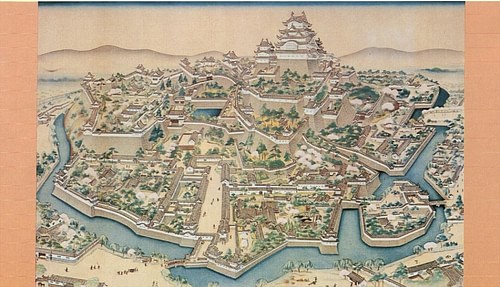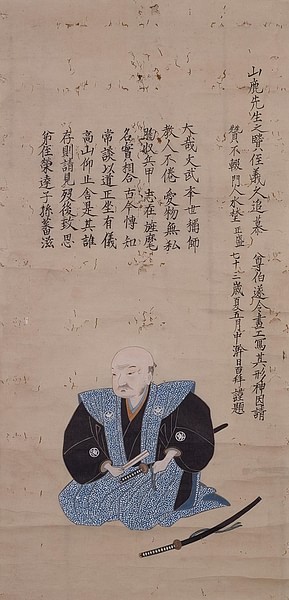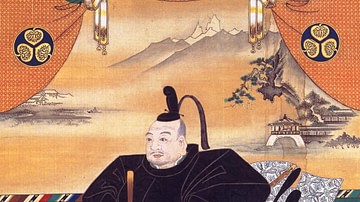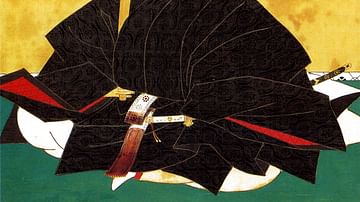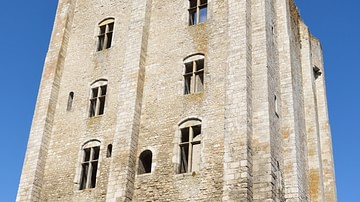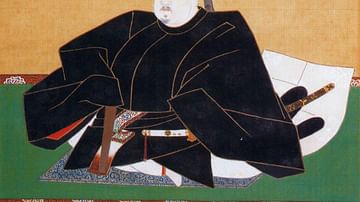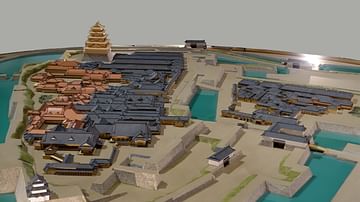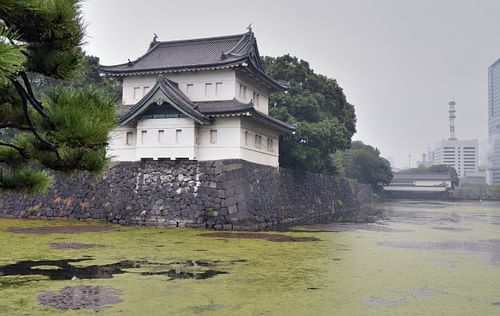
The Edo Period refers to the years from 1603 until 1868 when the Tokugawa family ruled Japan. The era is named after the city of Edo, modern-day Tokyo, where the Tokugawa shogunate had its government. It is also sometimes referred to as the early modern period because it was at this time that many of the characteristics of modern Japanese society were formed.
Political Structure
In 1600, Tokugawa Ieyasu (1543-1616) led a coalition of daimyo from eastern Japan to victory against a similar coalition of daimyo from western Japan at the Battle of Sekigahara. This battle brought an end to the prolonged period of civil war Japan had experienced in the preceding 140 years. In 1603, following the precedent of Minamoto no Yoritomo (1147-1199), Ieyasu had the emperor appoint him as shogun. The imperial family had no real power at this time, but it did have the capacity to confer political legitimacy through such titles. Using this appointment, Ieyasu created his own military government, which in Japanese is called a bakufu. While the Tokugawa were the single most powerful warrior family, Ieyasu lacked either the strength or desire to destroy all the other warrior families and create a centralised state. Instead, he put in place a system in which local daimyo were largely left in control of their own territory in exchange for recognising Tokugawa rule at a national level.
The Tokugawa controlled about 30 per cent of the land in Japan, and the rest was in the hands of about 270 daimyo families. Ieyasu divided these into three groups:
- sankei daimyo – collateral branches of the Tokugawa family
- fudai daimyo – who had sworn allegiance to Ieyasu before the Battle of Sekigahara
- tozama daimyo – who had only sworn allegiance to Ieyasu after the Battle of Sekigahara
The land controlled by these daimyo was called a han. The size of a han was measured, not in land area, but in the amount of rice it could produce in a unit called a koku. The fudai daimyo were more trusted, and their han, which tended to be relatively small, were located in key strategic locations in central Japan. The han of the less-trusted tozama daimyo were much larger but located far from the centre of Japan.
The Tokugawa put in place a whole series of measures to control the daimyo. For example, edicts were issued restricting the size of daimyo armies; they were only allowed to have one castle in their territory, and they were not allowed to repair fortifications without approval. The Tokugawa built a large Castle in Edo, and from the 1630s, daimyo were required to spend alternate years living in Edo and in their own territories. Their families had to stay in Edo permanently where they were, in effect, hostages.
As part of its system of social control, the Tokugawa also created a four-tier hereditary class system. Warriors, who made up about 7% of the population, were at the top, followed by farmers, artisans, and merchants. One goal of this system was to reduce the level of violence in society by restricting the number of people who had access to weapons. The circumstances in which warriors could engage in violence were also restricted. One more measure the Tokugawa took was to restrict contact between Japan and foreign countries. Europeans had come to Japan in the 16th century in order to engage in trade and spread Christianity. The Tokugawa feared that they might provide support for rebellious daimyo, so they banned Christianity and expelled all Europeans except the Dutch who were allowed to trade in the port of Nagasaki.
Historians call the political structure created by the Tokugawa the baku-han system because it was made up of the bakufu and the han. It is sometimes described as a form of feudalism in medieval Japan, but this suggests that it was similar to the political system in Europe in the Middle Ages, which was not the case at all.
The Period of Economic Growth
In the period from 1600 to 1720, the population of Japan roughly doubled from 15 million to 30 million. This rapid increase was possible because, whatever shortcomings the Tokugawa political system may have had, it brought peace after many years of civil war. Freed from the depravations of rampaging armies, farmers were able to put more effort into feeding themselves and their families.
Daimyo also had considerable incentive to increase the productivity of their land. While the Tokugawa did not directly tax daimyo income, they did impose various kinds of financial burdens on them. The most onerous of these were the costs involved in the alternate attendance system that could consume up to 40% of their income. As a consequence, daimyo were frequently short of money. There were two ways this problem could be alleviated. One was to try and extract more tax from the farming population. This was often attempted, but farmers had a variety of ways of resisting this. A more successful method was to try and increase the overall productivity of their territory. To this end, some daimyo encouraged the opening up of new agricultural land, the development of irrigation, the use of improved farming methods and the production of cash crops such as cotton and silk, wax, paper, and salt, which could be sold outside their territory. This led to the growth of trade at local, regional and national levels and the emergence of a commercial economy.
A New Urban Culture
The expansion of population and trade led to greater urbanisation. At a regional level, towns developed around local castles. The size of the castle depended on the wealth of the local daimyo. Some were small but others, like Himeji Castle, were huge. The warrior population was encouraged to live in these towns where they worked on the various administrative tasks necessary to run the local government. Gradually these warriors changed from a class of fighters to civil administrators.
The warrior class required various kinds of products and services so artisans and merchants were also drawn to the towns that were divided up into different sections according to the class system. In towns like Hagi and Kanazawa, parts of these Edo period districts have survived to the present day where they are popular tourist attractions. At a national level, Edo, Osaka and Kyoto developed as very large cities. By the end of the 17th century CE, Edo had a population of more than one million people and was the largest city in the world. Warriors made up a high proportion of the population in Edo because it was the political centre of Japan. In contrast, Osaka developed as the major commercial centre in western Japan, and it came to be dominated by merchants. With the imperial family living there, Kyoto remained the capital of Japan, and it was known for its aristocratic high culture.
In the second half of the 17th century, new forms of culture developed in these cities that reflected the lives of ordinary people. In the Edo period, prostitution was legal, but it was restricted to so-called 'pleasure quarters'. While the working conditions of women employed in these areas were terrible, they became the centre of a prosperous entertainment business. In Japanese, this was referred to as the ukiyo, which means 'floating world'. This was originally a Buddhist term meaning the 'fleeting world,' but it came to be used to refer to the prostitutes and their clients who frequented the pleasure quarters.
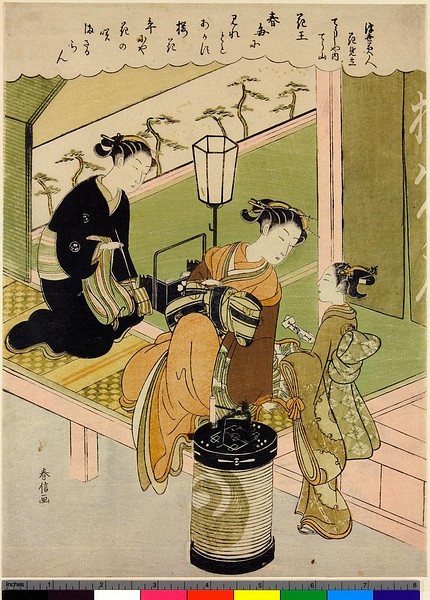
Closely associated with this was the rise of two new forms of theatre: bunraku, which was a form of puppet theatre, and kabuki, which used actors. At this time the most famous playwright was a man called Chikamatsu Monzaemon (1653-1724), and through his plays we can gain an insight into what Japanese society was like at the time. Ihara Saikaku (1642-1693) wrote novels about the lives of the new urban class, and Matsuo Basho (1644-1694) developed haiku poetry into a refined art form. Hishikawa Moronobu (1618-94) vividly portrayed scenes from the 'floating world' in a new art form called ukiyo-e (pictures of the floating world).
The Spread of Neo-Confucianism
The 17th century was also a period of innovation in the intellectual world. Before 1600, Shinto and Buddhism were the dominant religions in Japan, but in the 17th century, Confucianism also became influential. Confucianism developed in China in the 5th century BCE, but at that time it was little more than a system of ethics related to how individuals and rulers should behave. After the spread of Buddhism to China from India in the 2nd century CE, however, Confucian intellectuals began to develop a much more sophisticated set of ideas. In the Song period (960-1279) thinkers like Zhu Xi (1130-1200) developed Neo-Confucianism, a comprehensive theory of the individual, society, and the universe.
One of the central ideas in Neo-Confucianism is that human nature is essentially good, but that goodness can be clouded by engagement with the world. To restore the original goodness, it is necessary for individuals to engage in self-cultivation. Some of the Neo-Confucian ideas were introduced to Japan in the Kamakura period (1185-1333) and then in the Muromachi period (1333-1573) along with new types of Buddhist thought. It was only in the early Edo period, however, that Neo-Confucianism developed as a separate school of thought distinct from Buddhism. Early Confucianists were treated with suspicion by the Japanese government because they were thought to be advocating some form of Christianity, which the Tokugawa had banned in the 1620s. Gradually, however, a class of independent scholars appeared that made a living by teaching Confucianism.
It was once thought that Confucianism was simply a conservative ideology that supported the hierarchical social order imposed on Japan by the Tokugawa. More recent research, however, has pointed out that this was not the case. In China, Confucianism was part of the state apparatus. In order to become a government official, it was necessary for people to pass the civil service examinations of imperial China based on an understanding of the Confucian classics taught in government-sponsored schools. Although, in reality, only those from the wealthy elite could achieve this, in theory, government appointments were based on merit.
In Japan, however, the government was in the hands of a hereditary military aristocracy, and any suggestion that things should be otherwise was frowned upon. In this regard, one example of a scholar who got in trouble was Yamaga Soko (1622-1685). Yamaga was concerned by the fact that, since the coming of peace to Japan, warriors had lost their traditional role as fighters. He argued that, as the ruling class, warriors now had the obligation not only to govern but also to act as role models for other members of society. To do this, they should engage in self-cultivation in the fields of both military training and the literary arts. While Soko himself was banished from Edo for a time because some of his other ideas offended people in high places, other Confucian scholars like Ogyu Sorai (1666-1728) and Arai Hakuseki (1657-1725) were highly respected and become advisors to shoguns.
For Japanese scholars, there was one aspect of Confucianism that was especially problematic. That is, in Confucian thought, China was regarded as the 'middle kingdom' and surrounding countries were thought of as being 'barbarian'. Some Japanese scholars accepted the idea that Japan was inferior to China, while others criticized it. Applying the techniques of textural analysis they had learnt from Confucianism itself to the study of ancient Japanese literature, the critics argued that Japan was actually superior to China. Some drew on Shinto ideas about the divinity of the imperial family while others argued that the true spirit of Confucianism had been lost in China but maintained in Japan. In Japanese, this kind of thought is called kokugaku (national learning) and it represented a form of early nationalism.
The Ako Incident
At the beginning of the 18th century, the Ako Incident took place in Edo, which symbolized how much Japanese society had changed during the 17th century. In 1701, the Lord of Ako (a domain in western Japan), Asano Naganori, attacked an official called Kira Yoshinaka within Edo Castle while preparing for a court ceremony. Kira was only slightly injured but disturbing the peace in this fashion was a capital offence. Asano was ordered to commit seppuku, which was the way warriors were executed at the time. His domain was also confiscated, and this meant his retainers became ronin or masterless warriors.
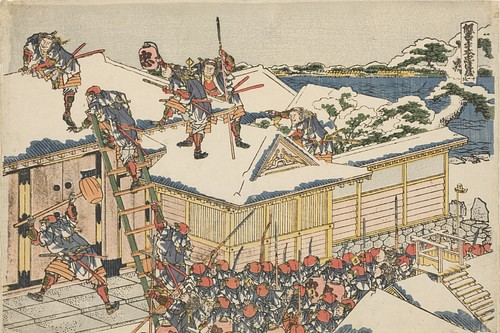
47 of these ronin organized a secret plot against Kira because they believed he was responsible for the death of Asano. About two years later, they carried out a surprise attack on Kira's mansion and killed him. His severed head was taken to a nearby temple where Asano was buried. There the plotters waited until the authorities arrived. They were arrested, and after an investigation by government officials, they were also ordered to commit seppuku. This verdict was important because it shows that, despite the retainers demonstrating warrior-like loyalty towards their former lord, the government was not willing to tolerate random acts of violence.
The End of Tokugawa Rule
From about 1720, the increase in population came to an end, and it stayed stable at around 30 million up until the end of the Edo period. Partly this was because people chose to have fewer children in order to maintain their standard of living. It also reflected the fact that, given the level of available technology, the human population had reached its ecological limits. Japan experienced numerous famines and other natural disasters that killed many people. This deteriorating economic situation began to put pressure on the Tokugawa political system at a time when a threat from overseas was on the horizon.
In the early part of the Edo period, the bakufu had been able to expel most Europeans because the level of technology in Japan and Europe was similar. Throughout the Edo period, the government had required Dutch traders in Nagasaki to provide it with reports about conditions in the outside world. Also, in the 1720s, the eighth shogun Tokugawa Yoshimune relaxed rules about the importation of foreign books. The translation of these books led to the growth of Rangaku or 'Dutch Learning', which involved the study of European scientific ideas. For these reasons, despite the restrictions on contact with foreign countries, the government was not completely unaware of events taking place outside Japan. From the late 1700s, however, foreign ships began visiting Japan requesting that the country open up for trade. These overtures were all rebuffed.
From the late 18th century, England and other European countries began to experience the Industrial Revolution. The invention of the steam engine greatly enhanced production and also led to the development of railways and steam-powered ships. It also led to the production of improved weapons that gave Europeans a decisive advantage in warfare. In the 1840s, the British victory in the Opium War against China made Japan's leaders realise that the 'foreign barbarians' posed a real threat to Japan. In 1853, the American Mathew Perry (1794-1858) led a squadron of steam-powered ships armed with Industrial Age weapons to Japan and demanded that the country open up for trade. In the following year, the bakufu reluctantly signed an agreement with the US that partially lifted the restrictions on foreign visits. Another agreement was signed in 1858 that opened up more of the country, and this was followed by similar agreements with the United Kingdom, Russia, and France. The perceived weakness of the bakufu's response to the foreign threat made it vulnerable to a challenge from domestic opponents. This challenge was led by two of the largest tozama daimyo, Satsuma in Kyushu and Choshu in western Honshu.
In theory, the bakufu governed Japan on behalf of the imperial family. This was a convenient political fiction for the Tokugawa in the early Edo period because it legitimised their rule. Basing their opinion on the study of Japanese history, however, critics began to argue that the Tokugawa had illegitimately usurped the authority of the imperial family and demanded that this be returned. They linked this demand to the threat from foreign countries through the slogan sonno joi, which means "revere the emperor, expel the barbarians." There were attacks on foreigners in both Choshu and Satsuma, but in response, European ships bombarded facilities in those two areas. This show of force demonstrated that trying to expel the barbarians was not practical, and so renewed efforts were put into overthrowing the bakufu. After a brief civil war, the last shogun Tokugawa Yoshinobu (1837-1913) decided to return his authority to the imperial court in an event known as the Meiji Restoration. In this way, the Tokugawa rule came to an end.
In the decades after the end of the Second World War in 1945, historians in the English-speaking world tended to have a very negative attitude towards the Edo period. This was because they believed it was the source of the militarism that characterised Japanese society in the 1930s and 1940s. Following the success of Japan's post-war democracy and the rapid growth of its economy from the 1960s, however, this view has largely been revised. Today, while not denying its dark side, the Edo period is generally regarded positively as a time when Japanese society developed some of its most distinctive features.
